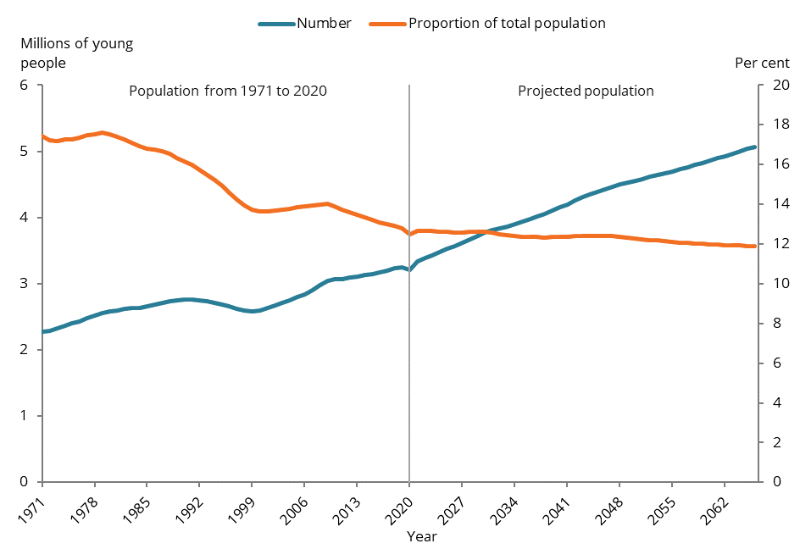Demographics of Australian young people and their families
On this page:
How many young people are there in Australia?
In 2020, an estimated 3.2 million young people aged 15–24 lived in Australia, making up 12% of the whole population (ABS 2020a). Key demographic information for young people based on 2020 data (or the latest data available) follows. Updates to some of the demographic information will be available from the 2021 Census:
47% (or 1.5 million) of young people were aged 15–19 and 53% (or 1.7 million) were 20–24
25% (or 814,000) were born overseas, with the largest populations from China (excluding special administrative regions and Taiwan) (4.5% or 148,000), India (2.7% or 87,600), New Zealand (1.9% or 63,200) and England (1.7% or 56,500) in 2019
Where do young people live?
In 2020, the population distribution of young people aged 15–24 is similar to that for all Australians. Most young people lived in New South Wales (31% or 1.0 million) followed by Victoria (27% or 850,000), Queensland (21% or 658,000), Western Australia (10% or 321,000), South Australia (6.8% or 216,000), Tasmania (2.0% or 62,700), the Australian Capital Territory (1.8% or 56,500) and the Northern Territory (1.0% or 31,200) (ABS 2020a). All states and territories had similar proportions of young people, ranging between 12% and 13% (ABS 2020a).
In 2019, of young people aged 15–24:
- 75% live in Major cities (2.4 million young people)
- 16% live in Inner regional areas (528,000)
- 7.1% live in Outer regional areas (233,000)
- 1.6% live in Remote or Very remote areas (53,000).
How has the proportion of young people changed over time?
From 1971 to 2020, among young people aged 15–24 in Australia:
- the population has grown, on average, from 2.3 million to 3.2 million
- their proportion relative to the Australian population has been steadily declining (from 17% to 12%) due to sustained low fertility and increased life expectancy (also referred to as ‘population ageing’) (Figure 1).
From 2021 to 2066, projections suggest that:
- the proportion of young people relative to the Australian population will remain much the same until 2066
- the number of young people will continue to grow, from 3.2 million in 2020 to 5.1 million in 2066 (Figure 1).
Figure 1: Number of young people aged 15–24 and proportion of the total Australian population, 1971 to 2066

Note: The vertical line indicates 2020. Population projections (from 2021 onwards) are based on ABS Projection Series B. See ABS 2018b for the assumptions on which Projection Series B is based.
Chart: AIHW.
Sources: ABS 2017b, 2018a, 2018b, 2020a.
What are the common living arrangements of young people and how has this changed?
In 2017–18, the majority of young people aged 15–24 lived with their parent or parents as either a dependent student (46% or 1.4 million) or a non-dependent child (a person without a spouse or offspring in their own household who is not a full-time student) (29% or 884,000). For information on young people in out-of-home care, see Young people in out-of-home care.
A far greater proportion of young people aged 15–19 lived as a dependent student (74% or 1.1 million) than in other living arrangements. The next most common living arrangements were:
- as a non-dependent child (19% or 275,000 young people)
- as an other related individual (for example, niece or nephew) (2.3% or 33,200) (ABS 2019c).
20–24 year olds had a broader range of living arrangements than 15–19 year olds, with most living as non-dependent children (37% or 613,000) followed by:
- 21% (or 350,000) as dependent students
- 17% (or 283,000) with a husband, wife or partner; 13% without children and 3.6% as a parent with any number of children aged under 15
- 14% (or 227,000) with a non-family member (ABS 2019c).
From 2007–08 to 2017–18, the proportion of young people aged 15–24 living with their parent/s (as a dependent student or non-dependent child) increased from 69% (or 2.0 million) to 75% (or 2.3 million):
- This increase was larger for 20–24 year olds (from 48% or 701,000 to 58% or 958,000) than for 15–19 year olds (from 91% or 1.3 million to 94% or 1.3 million) (ABS 2019c).
A 2019 analysis of longitudinal data from the Household, Income and Labour Dynamics in Australia Survey compared how the rates of young people aged 18–29 who moved out of and back in to their parental home changed over time. This analysis found that the higher proportion of young people living at home in recent years is driven by a lower proportion moving out, and not a growth in the proportion moving back in to their parental home (Wilkins et al. 2020).
The analysis suggests that young people are living with parents for longer due to social developments and economic, educational and cultural reasons. These include broad trends such as:
- marriage decline
- increased participation in post‑school education
- the decline in employment opportunities for young people (Wilkins et al. 2020).
See also COVID-19 and the impact on young people for information on young people who reported changes to their living arrangements during the COVID-19 pandemic.
ABS (Australian Bureau of Statistics) 2017a. Religion in Australia—Census of Population and Housing: Reflecting Australia - Stories from the Census, 2016. ABS cat. no. 2071.0. Canberra: ABS. Viewed 19 April 2021.
ABS 2017b. Australian demographic statistics, Jun 2017. ABS cat. no. 3101.0. Canberra: ABS. Viewed 19 April 2021.
ABS 2018a. Australian demographic statistics, Jun 2018. ABS cat. no. 3101.0. Canberra: ABS. Viewed 19 April 2021.
ABS 2018b. Population projections, Australia, 2017 (base) to 2066. ABS website. Canberra: ABS. Viewed 19 April 2021.
ABS 2019a. Microdata: Disability, ageing and carers, Australia, 2018. ABS cat. no. 4430.0.30.002. Canberra: ABS. AIHW analysis of TableBuilder data.
ABS 2019b. Disability, ageing and carers, Australia: summary of findings. ABS website. Canberra: ABS. Viewed 19 April 2021.
ABS 2020a. National, state and territory population. ABS website. Canberra: ABS. Viewed 15 December 2020.
ABS 2020b. General Social Survey: summary results, Australia. ABS website. Canberra: ABS. Viewed 15 December 2020.
ABS 2020c. Estimated resident population, country of birth, age and sex – as at 30 June 1996 to 2019, People, Population. Viewed 6 November 2020.
DoHA (Department of Home Affairs) 2020. Settlement data reports — financial year 2019–2020. Viewed 6 November 2020. www.data.gov.au
Wilkins R, Laß I, Butterworth P & Vera-Toscano E 2020. The household, income and labour dynamics in Australia survey: selected findings from waves 1 to 19: the 14th annual statistical report of the HILDA survey. Melbourne: Melbourne Institute. Viewed 19 April 2021.
ABS data sources
- At the time of this report, the ABS estimated resident population presented in Australian Demographic Statistics is based on biological sex and does not distinguish by sex other than males and females, see the ABS Standard for Sex, Gender, Variations of Sex Characteristics and Sexual Orientation Variables for more details.
- Sexual orientation is identified in the General Social Survey. Respondents are asked which of the following best describes how they think of themselves: straight (heterosexual); gay or lesbian; bisexual; or other sexual orientation.
There is variation in the collection of data involving sexual orientation and estimates may vary depending on the methods used. - 8.8% (or 262,000) of young people aged 15–24 chose not to state their religious affiliation in the 2016 Census of Population and Housing.
- A carer is a person who provides any informal assistance (help or supervision) to people with disability or older people (aged 65 years and over). The assistance must be ongoing, or likely to be ongoing, for at least six months. In the ABS Survey of Disability, Ageing and Carers a primary carer is a person who is aged 15 or over and provides the most informal assistance to a person with one or more disabilities, with one or more of the core activities of mobility, self-care or communication. For more details refer to Appendix – carers – Disability, Ageing and Carers, Australia: Summary of Findings methodology.
Other sources
The Australian Refugee and Humanitarian program can be accessed by people in humanitarian need who are: outside Australia (offshore), and need to resettle to Australia when they do not have any other durable solution available; and already in Australia (onshore), and who want to seek protection after arriving in Australia.
For general technical notes relating to this report, see also Methods.









